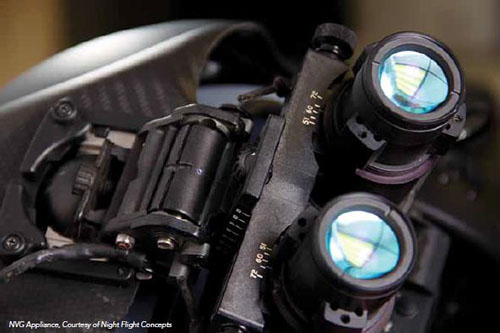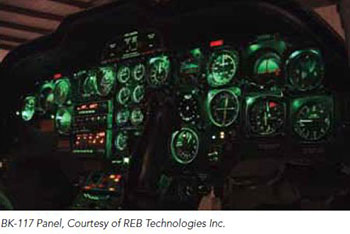
NIGHT VISION IMAGING SYSTEMS – A MECHANIC’S VIEW


By: Fred Polak
Night vision imaging systems (NVIS) aren’t just for military or police units anymore. In January 1999, NVIS entered the world of commercial aviation for the first time. The FAA issued a supplemental type certificate (STC) that allowed the use of night vision goggles (NVG) by a civilian helicopter operator who was providing emergency medical services (EMS). The advantages that NVIS technology brings to the aviation community (and helicopter operations in particular) are numerous. NVIS improves flight crew situational awareness and dramatically reduces the possibility of a collision with terrain or man-made obstructions. It significantly increases safety when flying in the dark — and safety is what it is all about.
In order to look at NVIS from a maintenance perspective, we are going to talk with Adam Aldous, president and CEO of Night Flight Concepts, a l company providing comprehensive NVIS solutions featuring training, equipment, maintenance services and consulting options.
About the Company
Night Flight Concepts was formed in 2006 by experienced civil and U.S. Army aviators, maintenance technicians and safety officers. The company has more than 50 years of combined aviation experience performing flight operations around the globe in all environments. Night Flight Concepts was formed to meet the challenging need and continuing growth of NVG operations within the United States and abroad, particularly for law enforcement agencies, air medical/rescue services, military organizations and government task force agencies who are our “first responders.”
HeliMx– Hello, Adam. How would you describe the relationship of NVG and aircraft lighting?
Aldous – The purpose, and possibly more important, the reason we need to have the internal and external lighting of an aircraft “modified” in order to harmoniously work with the NVG appliance is due to the emitted light energy from instruments, radios and any other avionics equipment in the aircraft which negatively affect the operation of the NVG appliance. So the next logical question might be why there are negative effects, and what are they?
Although the NVGs are not in any way, fashion or form connected to the aircraft, they are operated in the aircraft and in close proximity to the various lighting systems in the cockpit or aft cabin. Additionally, it is important to understand how the NVG appliance works. How can a pilot or crewmembers see with NVGs? A very basic theory of operation is that the lens on the end of the NVG (objective lens) allows light to enter the system. The light is then amplified thousands of times by an image intensifier in order for the operator to see in very low ambient light levels. The amplified image is then projected on another lens (eyepiece lens) so the user can see. The image intensifier is very sensitive to infrared (IR) light, and therefore, due to the inherent IR light that is emitted from all of the avionics equipment in the aircraft, the lighting needs to be modified to block out that IR light energy. The modification is completed using a number of various modification methods to include filtered lights and screens, post lights and flood lights, internal lighting of instruments and radios, and the aircraft design configuration.

HeliMx– In what way, if any, has the NVIS lighting been optimized for helicopter use?
Aldous – The NVIS lighting has been optimized for use with the NVG appliance while maintaining the original lighting purpose, which is to illuminate the various instruments, overhead panels, radios and any other avionics equipment installed in the aircraft. Arguably the most difficult task is to maintain the ability to clearly identify all range markings, numbers and other information on multifunctional displays during the daytime. The “daylight readability” is sometimes difficult to maintain due to the color (typically a greenish tint) of the filters used, especially over time when the filter begins to lose its effectiveness or it becomes scratched from misuse.

HeliMx– Is there a particular sensor package required for NVIS operations?
Aldous – Remember that NVIS, in the general sense, is referring to the entire system (both NVIS lighting and the NVG appliance). The NVG appliance acts as a sensor as it responds differently to various wavelengths of light. As mentioned earlier, the NVG is most sensitive to light energy in the near-IR spectrum and less sensitive to light in the UV spectrum and visible light spectrum (VLS).

The objective lens on the end of the NVG filters specific wavelengths of light. There are mainly two types of objective lens used in civil aviation. They are categorized as Class A and Class B. Generally speaking, a Class A lens allows 50 percent light transmission at 625 nanometers (nm) and a Class B lens allows 50 percent light transmission at 665nm. What this means is that the Class A lens will allow more wavelengths of light to enter the image intensifier and be amplified than a Class B lens. It also means that a Class B lens will allow the NVIS lighting system OEM more flexibility in the lighting modification process to use colors such as amber and red that may be prevalent in master caution warning systems, or the various colors on a multifunctional display. Put another way, if the aircraft lighting is modified to Class B specifications (meaning that the lighting may emit light up to 665nm), and the NVG being used is a Class A lens (meaning the NVG lens allows light transmission up to 625nm without any negative effects), then the NVG operator may experience some visual blooming effects. This can cause a reduction in visual acuity of the NVG due to the additional light being emitted above 625nm (625-665nm).
HeliMx– Is there any requirement for a specific type of panel lighting to be employed?
Aldous – As mentioned earlier, all of the lighting in the aircraft must be modified to not negatively affect the operation of the NVGs. Since there are a number of different types of panel lighting, the NVG lighting type chosen by an OEM should incorporate a number of modification methods for the existing panel lighting.
HeliMx– Can the operator customize the NVIS lighting?
Aldous – This is where operators are currently getting in trouble. Once the aircraft modification is complete and an STC is issued, the lighting modification and aircraft configuration is “locked in place” and should not be altered in any manner without following the appropriate steps through an engineering change order (ECO). An ECO is used to make minor changes to the configuration of the aircraft. Some things that may require an ECO include equipment relocation, adding new previously-approved equipment, wiring/electrical changes, updating of the lighting system and updating depiction of aircraft equipment. The ECO should be requested from the operator to the NVG lighting OEM.
 HeliMx– Is there more than one STC for the system?
HeliMx– Is there more than one STC for the system?
Aldous – The STC for NVIS lighting is specific to each make and model aircraft, and may even be specific for the same make and model, depending on the specific aircraft configuration.
HeliMx– Does it matter if the aircraft is flying IFR or VFR?
Aldous – The entire lighting system needs to be functional during all modes of flight. When operating with NVGs, the user is strictly operating in VFR. Although the NVG will allow the user to see through thin obscurations such as light rain, snow, clouds or fog, NVG operations are only authorized for VFR flight.
HeliMx– Who typically does an NVIS lighting installation?
Aldous – Typically the NVIS lighting OEM will have one of their own A&Ps or IAs complete the modification, or a certified completion center.
HeliMx– Are there any special mechanical or electrical requirements to be considered for an installation?
Aldous – This is typically addressed in the instructions for continued airworthiness (ICA) and aircraft mechanical and electrical diagrams as applicable.
HeliMx– Is there a specific number of line replaceable units (LRUs) in the system?
Aldous – The number of LRUs will vary as a function of the aircraft make and model, the NVG lighting OEM and the modification method employed.
HeliMx– How is the NVIS tested?
Aldous – When determining the testing, inspection and/or certification of an NVIS, it is important to remember there are two basic components of the NVIS to consider: the lighting system and the NVG appliance. They both require some form of scheduled maintenance in order to comply with continued airworthiness. The FAA has adopted the requirements set forth in minimum operational performance standards for integrated night vision imaging system equipment (RTCA/DO-275), which contains the complete description and minimum performance standards of the NVG and cockpit lighting modifications appropriate to civil aviation. The RTCA/DO-275 states: “As a minimum, the schedule shall include a 180-day inspection of the NVG appliance and a 24-month NVIS validation test.”
Let’s first discuss the NVIS lighting system. Section 91.205(h) of the FAR states: “For night vision goggle operation, the following instruments and equipment must be installed in the aircraft, functioning in a normal manner, and approved for use by the FAA,” and “… interior and exterior aircraft lighting systems required for night vision goggle operations …” 14 CFR 91.205(h)(3). This is conducted only through the original or amended type certificate or an STC. A field approval 337 is not authorized. “Based on 14 CFR 21.93(a), the Rotorcraft Directorate considers modification of aircraft lighting for the purpose of performing NVG operations as a major change because it changes the operational characteristics, or other characteristics affecting the airworthiness of the aircraft, and thus an STC is required” (FAA legal interpretation, Office of the Chief Counsel, AGC-200, May 9, 2011).
Once an aircraft lighting system has been modified for NVG operations, inspected and certified for flight, all documentation approved by the administrator, STC issued, and acceptance by the operator, the operator is then responsible to maintain the integrity of the STC and airworthiness of the NVIS lighting system. This is done by adhering to the instructions for continued airworthiness (ICA) issued by the STC holder. The ICA from one STC holder to another of the same make/model aircraft may vary and therefore, it is important to ensure you are at a minimum adhering to the ICA for the specific aircraft serial number that was approved and issued. A simple request from the operator to the STC holder on an annual basis can help ensure the current STC and any revisions are received and implemented as appropriate.
NVIS is another tool to help helicopter operators provide increased safety and situational awareness in the cockpit and in the dark. NVIS … can you see me now?
